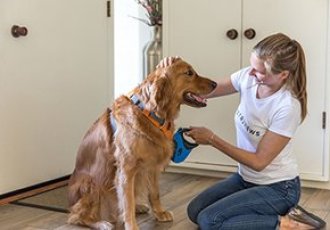We recommend these products based on an intensive research process that's designed to cut through the noise and find the top products in this space. Guided by experts, we spend hours looking into the factors that matter, to bring you these selections.

Ready to buy now? Shop the best:
From pint-sized Pomeranians to giant Great Danes, dogs of all shapes and sizes need comfortable, well-fitting collars.
When you're looking for a new dog collar, however, you may not know where to start, especially if you're a first-time dog owner. What types of collars are available? What material should you choose? How do you fit your dog for a collar? We at BestReviews will help you find answers to all these questions and many others on your quest to find the best collar for your pooch.
Our full guide to dog collars will help you give your canine companion the quality neckwear he deserves.

Flat collars are simple dog collars with a flat band that may or may not feature padding. Flat collars tend to be the most common option, available in a range of materials, colors, and styles. While great for most dogs, some pet parents find that this type of collar rubs the fur off long-haired pooches.
Rolled collars are tube-shaped rather than flat, with padding in the middle. While you can occasionally find nylon-rolled collars, most are made from leather or faux leather. These collars tend to be thinner than flat collars, but they're less likely to chafe long-haired dogs.
You can find dog collars in a wide range of materials. These are the most common options.
Pros:
Lightweight (may be less daunting for puppies or collar-averse dogs)
Wide range of colors and patterns
Fairly inexpensive
Cons:
Hard to clean without machine washing
Not the most durable option
Pros:
Extremely long-lasting and durable
Dries quickly; undamaged by regular exposure to water
Very comfortable for the dog
Cons:
More expensive than some other options
Pros:
Classic leather look without the use of animal products
Relatively inexpensive
May withstand wet conditions better than real leather
Cons:
Not usually very durable
Pros:
Durable and long lasting if cared for properly
Easily wiped clean
Smart and attractive appearance
Cons:
Smaller variety of colors or patterns
Can get stiff and crack if they get wet

Most dog collars come with one of two fastening types: buckle or snap. Each type has its good and bad points. The fastener may not be your primary consideration, but it's still worth mulling over.
Buckle-type fasteners resemble what you'd find on most belts, with a prong that fits into holes in the strap of the collar. They tend to be very durable, but they take longer to fasten and undo.
Snap-type fasteners are made of two plastic parts that slide into one another and clip together. They release by pressing on the sides, much like you'd find on a child's pushchair harness. While they can get damaged or become brittle in extreme cold, they release very quickly, which is useful in emergency situations.

Dog collars come in a wide range of prices, from less than $5 to as much as $100.
$5 to $20: You can find a good, basic nylon dog collar for less than $5, though most decent options can cost up to $20. Most faux leather dog collars fall into the $10 to $20 range, though those made from high-quality faux leather can cost more.
$15 to $40: While you can find cheaper neoprene options, expect to pay between $15 and $40 for a heavy-duty neoprene collar.
Up to $100: An average leather dog collar can cost between $10 and $30, but high-end options can cost up to $100.
Think about the width and weight of the dog collar. Wider, heavier collars are suitable for larger canines, whereas slim, lightweight collars are best for diminutive dogs.
Decide how adjustable the dog collar needs to be. You're less able to fine-tune the fit of a collar with a buckle fastener as opposed to one with a snap fastener.
Make sure the collar is comfortable for your dog. This should be one of your main concerns. A collar that rubs or pinches your dog is no good.

Q. What's the best sort of collar for an active dog who often gets wet and muddy?
A. If your canine companion loves swimming and isn't afraid of mud, you'll want a collar that's hard-wearing and easy to clean. Neoprene is probably the best choice because it stands up well to water and heavy use. We recommend a machine-washable collar for a pup who likes mud.
Q. Should my dog wear her collar indoors?
A. In most cases, it's unnecessary for your dog to wear her collar indoors. Not only is there a risk it could get caught on something, which could lead to a severe injury if you're not there to supervise, but wearing a collar for a long time can rub off your dog’s fur.
Q. Can I buy a collar for my puppy to grow into?
A. If you're buying a collar for a new puppy, it might be tempting to select a collar that would also suit his full-grown size to save yourself some money. However, a collar that your puppy can grow into will be much too big and heavy for him to use now. Not only is he likely to be able to slip out of it but it will also be too bulky for his small frame. Getting used to wearing a collar and walking on a leash is a big step for a young dog, so it's always best to start a puppy with a thin, lightweight collar.
Get emails you’ll love.
Learn about the products you’re wondering if you should buy and get advice on using your latest purchases.
